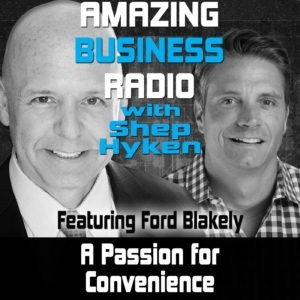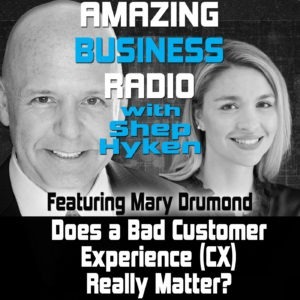Shep Hyken's Blog, page 124
July 1, 2019
5 Top Customer Service Articles for the Week of July 1, 2019
Each week I read a number of customer service and customer experience articles from various resources. Here are my top five picks from last week. I have added my comment about each article and would like to hear what you think too.
Is Customer Service The Same As Customer Experience? I Debate Myself by Steve Olenski
(Media Post) Like many others, I’m sure, I talk to myself quite frequently. And these conversations very often occur out loud versus internally — which apparently means I’m quite intelligent, as research has found that speaking out loud to yourself was found to be a trait of higher cognitive function.
My Comment: What’s the difference between customer service and customer experience? My short answer is that service is part of experience, but experience is much more. The author of this short article shares his take on the similarities and differences between the two.
Want to Consistently Deliver Remarkable Customer Experiences? Make Sure These 3 Departments Are on Board by Sonia Thompson
(Inc.) If one part of your customer journey is a hot mess, it can ruin all your efforts in other areas.
My Comments: While there is a customer service department (the agents who take calls from customers), my belief has always been that customer service is a philosophy – part of the company’s culture. That said, there are three more departments that must be on board to help support the customer service culture – and none of them take customer calls.
Stick to the customer experience fundamentals in a digital world by George Averling
(George Averling) I used to be bamboozled by the world of digital. The new language was scaring the pants off me. Digital disruption, IOT, AI, big data, sophisticated and mysterious algorithms, bots…and the list goes on.
My Comment: Companies that are resisting the “digital experience” are missing opportunities. Some organizations are resistant about moving from a traditional to a modern digital experience. Yet, often these digital changes are just making the basics better. This author makes the point with the example of Grab, a digital disrupter to the taxi business in Malaysia (and surrounding countries) that is similar to Uber and Lyft.
3 Tips to Empower your Sales Team, Inspired by Top Sales Organizations by Falon Fatemi
(Forbes) Business-to-business (B2B) and business-to-consumer (B2C) sales have traditionally been two different beasts, relying on two distinct sets of fundamentals and best practices. But times are changing.
My Comment: While the title of the article says sales, it’s all about making the customer experience better. Focusing on metrics, training and AI is this author’s formula for delivering a better experience that gets makes customers want to come back for more.
Six Steps to Successful Customer Journey Mapping by Natalya Bucuy
(LiveHelpNow!) A Mile in Their Shoes: How to create a visual representation of your customer’s experience with your brand.
My Comment: Journey mapping is a powerful exercise that all companies should practice. The process is part of creating deliberate customer experience success. This excellent article breaks down the process with six steps that it takes to work through this important exercise. By the way, journey mapping isn’t something you do just once. It must be revisited on a regular basis.
BONUS
“Play Gloria!” 10 Life Lessons from the 2019 Stanley Cup Champion St. Louis Blues by Chris Luecke
(Chris Luecke) Earlier this month, my hometown St. Louis Blues won their first Stanley Cup in their 52-year franchise history. In true St. Louis sports fashion, their road to the Cup was nothing short of magical.
My Comment: Earlier this month, the St. Louis Blues hockey organization won the Stanley Cup championship – after 51 years of being in the league. (I had been waiting a long time for this!) While hockey may be the backdrop of this article, there are plenty of lessons that we should share with our teams at work. While this is not a typical “Top Five” article on customer service and experience, I’m sure you’ll enjoy it – and learn from it.
The post 5 Top Customer Service Articles for the Week of July 1, 2019 appeared first on Shep Hyken.
June 28, 2019
Guest Blog: “Zhuzhing Up” Humans in the Contact Center
This week we feature an article by Chris Connolly that discusses h ow assistive AI blends with human-only qualities to create a new category of “superagents.”
Technology replacing humans. That’s what we all fear. Yet bank employees did not disappear with the advent of the ATM. Airline agents are still at check-in counters to guide passengers after self-service kiosks and to arrange complicated ticketing. Their roles have evolved, with the human performing critical value-added functions and machines handling rote tasks.
While machines are becoming more intelligent, humans aren’t moving out of the picture yet. It’s true that in China, in a case of life imitating art, state-run television is testing the world’s first AI news anchors more than 30 years after the Max Headroom television satire. But a much-ballyhooed automated hotel in Japan recently added more humans and scaled back on its droids due to inefficiency and cost-effectiveness, as did a grocery store which also had to deal with the “creepiness” effect.
In general, technology is augmenting —not replacing — the employee. In its recent jobs report, the World Economic Forum highlighted a curious feature of the revolution in artificial intelligence (AI) already underway in the tech-enabled workplace. Researchers predict that machines will perform more than half of current workplace tasks by 2025, up from 29 percent today. And yet, a net gain in human jobs is also expected. Why? Because of that word “current.” The World Bank finds in its 2019 examination of the workforce that while technology is indeed changing how people work, it’s also creating new opportunities.
As futurist Byron Reese points out, “Technology is really good about creating new good high-paying jobs, and it, in turn, destroys low-paying, lower-skilled jobs … the question to ask is not whether the people whose jobs are replaced by automation can do the new jobs. The question is, can everybody do a job a little bit harder than the one they’re doing now?” With the right training, they can, and the humans will continue to do the jobs that AI isn’t ready to handle.
Fewer phone calls, but more complex conversations
In the contact center industry, for example, there are fewer phone conversations going into customer support centers than in the past. Dimension Data research says that 56 percent of businesses expect transactions via telephone to fall over the next two years. But the phone conversations that are handled by human agents are generally becoming longer and more complicated as simpler inquiries are handled through self-service options.
Gartner estimates that by 2021, 15 percent of all customer service interactions will be completely handled by AI, an increase of 400 percent from 2017. As Reddit co-founder Alexis Ohanian said in a recent interview with NBC News: “We’re at a turning point now with the technology where automatable jobs are routine work, work that software could do better, cheaper and faster. … It’s going to be imperative that people are investing in skills that are non-routine skills … They are the jobs that AI won’t be able to do.”
In this world of increasing self-service interactions, the moments when a customer connects to a support agent are becoming less frequent. The calls that do go through to the contact center agent are for more critical interactions — involving complexities, emotions or higher values. This gives employees the opportunity to make a greater impact on the resolution to the issue, and on the overall customer experience. It’s, therefore, crucial to get exactly right these rare moments that offer the opportunity to nurture the relationship with the customer.
Faster than … more powerful than … it’s Superagent!
Companies are already augmenting contact center employee capabilities with new AI tools that free them from monotonous tasks and offer more power to resolve issues. These assistive technologies provide employees with hints, prompts, tips and even personalized promotions based on real-time, dynamic interpretation of what the customer needs or would find appealing.
As Bain & Company recently noted, AI-powered predictive technologies that can better match customer queries with employee skills will be able to “reduce costs, increase sales and saves, raise the level of customer advocacy, create more satisfying jobs, and keep talented agents engaged with the tasks where they are most proficient.” The next generation of AI-based tools will enable employees with near super-human capabilities to read customers’ linguistic and emotional cues, analyze interaction behavior, and predict their choices.
Feelings … nothing more than feelings
But these “superagents” of tomorrow will require a different combination of skills than those of today. Even as repetitive and trivial tasks are more frequently handled by bots, the need for empathy, intuition, common sense and problem-solving skills remain. There are times when consumers need to talk to a real person for reassurance, or for interactions requiring instinct, nuance and flexibility as part of the issues resolution process.
The research field called “emotional AI” or “affective computing” is not new, but is picking up steam today as part of a broader shift in expanding Natural Language Processing (NLP) to understand what humans mean to say and the emotion behind their words. But there remains an emotional intelligence divide between robots and humans as there is yet to be an AI able to effectively quantify human feelings and moods into unique data points or profiles. This lack of emotional intelligence is why AI-powered solutions can prove frustrating or even Big Brother-esque to customers at times, and why AI cannot completely replace humans.
New opportunities will continue to emerge where humans must step in to resolve the situations that bots cannot. The superagent of the future contact center will be a strong listener with the ability to understand the psychology of good customer experience. A superagent will be a fast consumer of data and information, making them contextually aware of customer situations — and never needing to rely on a prepackaged script. The superagent can easily shift between channels such as video, voice and text to make each interaction sound authentic and personal.
But a contact center employee won’t become a superagent organically. Employers and technology providers have a responsibility to make the adoption of new systems as easy as possible. The annual Forrester predictions guide points out that savvy companies will make joint investments in training as well as new technology to ensure employees are educated on “how expectations, skill sets and experiences will evolve” as AI makes greater in-roads in the workplace. The World Economic Forum’s 2019 report on job reskilling finds that it will be possible to transition as many as 95 percent of at-risk workers into positions that have similar skills and higher wages, although to achieve that level will be costly and require public-sector involvement.
Not going away
In the 2013 movie Her, the teaming of bots and humans led to an entirely new connotation for the term “work spouse.” In short, tomorrow’s superagent will be able to respond to both functional AND emotional customer needs while seamlessly collaborating with their machine-enabled co-workers.
Accountants today couldn’t imagine performing their job without some form of calculator. In fact, who would trust an accountant who did not use a machine to supplement their skills? In that same vein, the day will quickly arrive when no contact center agent will be able to deliver an exceptional customer experience without an AI-enabled counterpart. How could Will Robinson have survived the dangers of space without his robot sidekick?
Christopher Connolly is the vice president of solution strategy for Genesys. He is based in the company’s regional offices in the Raleigh-Durham area and can be reached at christopher.connolly@genesys.com or on Twitter at @ConnotronNY.
For more articles from Shep Hyken and his guest contributors go to customerserviceblog.com.
Read Shep’s latest Forbes article: Five Ways To Motivate Your Customer Service Team
The post Guest Blog: “Zhuzhing Up” Humans in the Contact Center appeared first on Shep Hyken.
June 26, 2019
Predictive Customer Support
 In the old days – and even in modern times – if a customer wanted help or support, they picked up the phone and called for help. A (hopefully) friendly and competent customer service professional, also known as an agent or representative, would answer the question or resolve the problem.
In the old days – and even in modern times – if a customer wanted help or support, they picked up the phone and called for help. A (hopefully) friendly and competent customer service professional, also known as an agent or representative, would answer the question or resolve the problem.
Today there are many ways to connect with a company. There’s the traditional phone call, email, messaging, instant chat, social channels like Twitter and Facebook, and many more. But there’s one mode of communication and customer support that hasn’t been talked about much. My prediction is that it will not only become popular, but a recognized standard that customers will come to expect. What I’m referring to is the concept of predictive customer support.
My simple definition of predictive customer support is that the customer gets the support not only before they know they need it, but before the problem ever occurs – because it’s predicted that it will occur.
A copy machine is a great example. It has sensors to give you warnings, so it can let you know when you’re running low on toner, for instance. That knowledge allows you to add toner before you run completely out, which would most likely happen during an important copy job. (Isn’t that the way it usually happens?) Crisis averted!
Here’s another example. Let’s say a customer calls for support. Thanks to good CRM (Customer Relationship Management) software, the agent knows who this customer is, when they last called, what they called about, what they’ve bought in the past, etc. A well-trained and experienced customer service agent will not only solve the customer’s current issue, but also anticipate their next question or problem. All of this is based on this customer’s previous behaviors, which align with patterns established by hundreds or even thousands of other customers. The patterns allow for predictions of the customer’s needs and suggest the best way to take care of them.
Technology can play a role in making these predictions. Rather than relying just on the customer support agents’ experience, AI (Artificial Intelligence) can play a role in making these predictions. Today, with alerts and predictive AI, problems can be discovered early – often before the customer knows about them, and in some cases, can be preempted with support and maintenance to prevent the problem ever happening in the first place. As much as technology can play a role in making these predictions, common sense and experience can also drive the predictive experience.
You don’t need ESP (extra-sensory perception) to practice predictive service. With the right tools, knowledge, and expertise, you can essentially “see into the future,” for lack of a better term. Once you’ve had a look, don’t wait for the customer to call you. Fix it before it’s a problem.
Shep Hyken is a customer service expert, keynote speaker, and New York Times bestselling business author. For information, contact 314-692-2200 or www.hyken.com. For information on The Customer Focus customer service training programs, go to www.thecustomerfocus.com. Follow on Twitter: @Hyken
customer service training programs, go to www.thecustomerfocus.com. Follow on Twitter: @Hyken
The post Predictive Customer Support appeared first on Shep Hyken.
June 25, 2019
Amazing Business Radio: Ford Blakely

A Passion for Convenience
Striking a Balance Between Business and Consumer Needs
Shep Hyken interviews Ford Blakely. They discuss pursuing your passion, creating convenience, and balancing technology with a human connection.








The Interview with Ford Blakely:
When faced with a problem, it’s important to approach it from the standpoint of convenience. How can you fix things to make them more convenient for your customers and employees?
The concept of convenience has come more front and center over the past few years. This is largely due to two main factors. First, the review economy put control in the hands of consumers and allowed them to advocate for what they wanted from companies. Second, the immediacy of convenience created an expectation of on-demand service, placing the importance on how companies deliver their service rather than just what their product is.
Even if they’re not your direct competitors, companies like Amazon and Uber have created an expectation of a certain level of guest experience thanks to technology and convenience. Your customers will come to desire and even expect this same level of service and guest experience from you, too.
There needs to be a balance with technology use. Some companies implement too much technology, sacrificing the human connection their customers crave. This can prove detrimental to business.
As with technology, there needs to be a balance between convenience for customers and convenience for employees/businesses. The goal should be to create convenience for all, but it should definitely be skewed in the customer’s favor. When in doubt, always do what’s best for the customer.
Quotes:
“The default should always be to do what’s best for the customer.” – Ford Blakely
“It’s not about what the business does or sells, but how they’re delivering their service.” – Ford Blakely
“Sometimes what you don’t know can be your best ally.” – Ford Blakely
“It’s simple. If you can combine two things that take extra effort into one… that’s convenience.” – Ford Blakely
About:
Ford Blakely is the founder and CEO of Zingle. He has been involved in startups, finance, and various entrepreneurial projects for over 20 years.
Shep Hyken is a customer service and experience expert, New York Times bestselling author, award-winning keynote speaker, and your host of Amazing Business Radio.
This episode of Amazing Business Radio with Shep Hyken answers the following questions … and more:
What is convenience?
How can I create convenience for my customers and employees?
How can I use technology to create convenience?
How can I balance business with consumer needs?
Can technology in business be a bad thing?
The post Amazing Business Radio: Ford Blakely appeared first on Shep Hyken.
June 24, 2019
5 Top Customer Service Articles for the Week of June 24, 2019
Each week I read a number of customer service and customer experience articles from various resources. Here are my top five picks from last week. I have added my comment about each article and would like to hear what you think too.
Customer Clairvoyance: I Never Knew I Always Wanted This by Chip Bell
(Forbes) Dartmouth business school Vijay Govindarajan and author of The Innovator’s Dilemma describes three barriers to brand survival in a changing world.
My Comment: Here is a great testimonial to the combination of a great customer experience and product. You know it happened when the customer says, “Wow! I never knew I wanted that.” It’s an Apple moment. Steve Jobs had the goal of giving a customer something they didn’t know they needed or wanted until they actually started using it. My friend Chip Bell, customer service expert, summarizes this idea quite nicely in this excellent article.
When We Stop Doing The Things That Made Us Great by Josh Linkner
(Josh Linkner) Last weekend, I went to one of Detroit’s most celebrated Italian restaurants. I’d been years ago and anticipated the same exquisite experience. Known for their impeccable service and inspired dishes, I was expecting them to nail every detail like they had in the past.
My Comment: I’ve written about this in a number of articles. Sometimes people (and business organizations) stop doing what made them successful. They get too busy and distracted with growth, new products, etc. In this case, it’s taking the eye off of reputation-making customer service. This article reminds us that no matter how busy we get, how innovative we become, and how much success we are enjoying, we can’t take our eye off of customer service.
5 Communication Tips That Will Boost Customer Trust by Syed Balkhi
(Business2Community) If you want the most loyal customers, ones that will stick around with you for a long time, you need to build customer trust. One of the best ways to build customer trust is by providing great customer service. When your customers know that you have their backs, they’ll have complete trust in you as a company.
My Comment: If you want customers to come back, they must have confidence that the experience they have with you will be consistent and predictable. This article focuses on one of the key strategies in driving customer confidence, and that’s creating trust. This is a list of the five basics that will help your customers trust you. Numbers one, two and four are non-negotiable. Do them. Number three may also be. Number five is can be optional, depending on your business. Great reminders here.
10 Examples of Great Customer Service by Nextiva
(Small Business Trends) To rake up great customer reviews or blow up on social media, it comes down to good ole genuine customer support.
My Comment: I am always reading about my favorite brands, hoping to gain insight into how they do what they do so well. This article lists ten brands, and you will recognize most of them. The author then teaches valuable lessons about each one. Imagine if you were to incorporate all ten of these into your business (and you probably can). The customer service you provide would be… Amazing!
Poor customer service can impact more than just those who experience it by Kristen Dalli
(Consumer Affairs) Most consumers can relate to either seeing or experiencing poor customer service, whether it’s at a restaurant, hotel, or the grocery store. But if you didn’t directly experience the poor service, do you react?
My Comment: Here’s an interesting concept: “Employees should be aware that their audience is much larger than the customer they’re focused on.” The premise of this short article is that the impact you have on a customer, especially if it’s negative, impacts the way other customers may perceive you. While the article uses customer service at a restaurant as an example, there’s enough info to make you start thinking about how the concept applies to your business.
BONUS
Guide: 8 Expert Tips To Go Omni-Digital by Dimelo
(Dimelo) In this white paper, a number of our expert’s breakdown why changing your strategy to unify your communications across multiple channels can help you adapt to changing customer behavior.
My Comment: The concept of “omnichannel” is about being available to your customers on multiple channels, such as phone, email, chat, messaging, social channels and more. Our friends at Dimelo released a report that includes eight “expert tips” on how to unify communication across these channels. I’m honored to be quoted in this report. By the way, you’ll have to share your name and email to get the report, but it’s worth it.
Shep Hyken is a customer service expert, professional speaker and New York Times bestselling business author. For information on The Customer Focus customer service training programs go to www.TheCustomerFocus.com. Follow on Twitter: @Hyken
customer service training programs go to www.TheCustomerFocus.com. Follow on Twitter: @Hyken
The post 5 Top Customer Service Articles for the Week of June 24, 2019 appeared first on Shep Hyken.
June 21, 2019
Guest Post: Chatbot vs. Live Chat – Which delivers the best customer experience?
This week we feature an article by Jonny Everett who discusses what businesses must do to be successful in the on-demand world in which we live.
Liquid expectations and the on-demand world
We live in an on-demand world. Your customers are used to ordering a taxi, booking hotel rooms and getting their shirts dry-cleaned in a few taps of their phone screen or clicks of their mouse.
Customers can get the service they want, when they want it, how they want it.
Those brands leading this wave – the Ubers, Booking.coms and FlyCleaners of the world – used to be disruptors. They used to be the alternative. That’s not the case anymore.
They’re continuing their aggressive growth. Their once-disruptive ease of use is now the norm. Their customers aren’t cash-strapped market segments. Their customers are your customers. They’re you and me. And amongst that shared audience, their customer experience becomes the expectation set on your brand.

Accenture calls these new, slippery customer expectations liquid expectations. Consumers have been in disruptors’ marketing, customer interaction and customer experience for so long that their ease-of-use, millennial-friendly, low-commitment selling points are no longer isolated in industries or verticals. This new set of customer expectations is portable; your customers are bringing their experience with the Netflixes and AirBnBs of the world to you. If I can change my billing details in 3 taps and a card scan in their app, why do I have to be on the phone for 20 minutes with your company just to be told I need to quote a reference number I lost five years ago?
Customer expectations are out of your hands. They’re out of your industry’s hands. They’re not restricted by physical location, cultural context or social segment.
Ease of use has gone global. Customer experience has been democratized.
Accessibility and the on-demand consumer
Your customers don’t want to wait. Your customers don’t want to opt in or call up. The increased customer accessibility pioneered in the past decade by digital disruptors demonstrates what customers have come to expect. Digital has enabled the on-demand customer and, in turn, the on-demand customer has set the bar high for access to your brand. You don’t want to fall short.
Accessibility isn’t just about product, device, service or channel design. Accessibility is the commitment of brands to deliver experiences and customer contact in a holistic process that harnesses both customer communication methods and the understanding that each of your on-demand customers is a (drumroll) human. It’s the promise of brands to give a one-to-one customer experience to every customer, on-demand.
Chatbots and live chat for the on-demand consumer
The on-demand world requires channels that reflect the accessible, liquid expectations of consumers.
Think of how you contact friends and family. WhatsApp, iMessage, Messenger and good old SMS. Now think of how the Ubers and AirBnBs of the world allow customers to engage with their brand. More often than not, they’re the same or very similar channels.
Chat reflects the customer-centric desires of on-demand consumers:
I want the contact on my schedule
I want the contact to be an instant interaction
I want the commitment to be suited to my lifestyle
With chat channels available, I access a brand on my schedule, in a channel I use every day, while I order a latte through a Starbucks app, pay for my ASOS order and text my mom back. These events can happen simultaneously, all within similar channels. My liquid expectations are transferred and met in each scenario.
Chat provides customers instant, accessible experiences. Chat channels are easy to staff 24/7, text-based, low-commitment, require low customer effort and provide increased access to your brand.
And if you’re reading this article, you probably already understand that chat can be leveraged in this way. Chatbot and live chat technologies are not new, but their utility as effective parts of on-demand consumers accessing your brand is.
Choosing between chatbots and live chat for your customer experience goals means evaluating your customer service and your brand’s values against the expectations of the on-demand consumer.

Chatbots are becoming every customer experience professional and marketer’s most prized possession for automated customer interactions.
Chatbots are simply machine-to-human, real-time text-based communication with your brand’s scripted FAQs. The scripted qualifier here is key; expectations that you can purchase a chatbot technology, stick it on your site and expect it to work are misleading. Chatbots require scripting from your existing human, customer-facing team. They require training. They require defined goals and monitoring for success.
Once these hurdles are passed, there are fantastic applications for chatbots to grant the on-demand consumer further access to your brand, especially where those interactions are defined process.
Across simple sales and customer support journeys, where conversations are process driven, chatbots can be used effectively. From checking an order status to password resets to guidance on returns, anything that’s structured in terms of the support journey is a really good opportunity for chatbots.
But what about more complex journeys? Enter live chat.
Fundamentally, live chat technology is a way of connecting people. It’s a technology that enables real-time, human-to-human interaction over text, bridging the gap between on-demand consumers who expect instant access to your brand.
Live chat flourishes in complex sales and customer support journeys. Our experiences of digital exchanges like booking a hotel room online or ordering an Uber are only considered good if the technology facilitating that exchange functions better and faster than a human alternative.
If we are purchasing a car, ordering a new bed or finally asking someone to marry us and purchasing an engagement ring, human-to-human interaction in a live chat meets consumers’ liquid expectations of access to your brand from pre-sale education to post-sale customer delight.
Equally, for complex customer service situations like technical troubleshooting or high-value order support, a live chat agent can provide an on-brand, human experience of your brand to loyal customers.
Conclusion
In the highly connected digital world, liquid expectations are a reality that all customer experience, service and marketing professionals have to deal with.
Your customers are bringing experiences from every other brand they come in contact with; your customer contact mix must meet those on-demand, primed consumers in the channels they use.
Jonny Everett is Co-Founder of The Chat Shop, providing award-winning UK and US live chat and chatbot outsourcing and consulting.
For more articles from Shep Hyken and his guest contributors go to customerserviceblog.com.
Read Shep’s latest Forbes article: Coach Of Stanley Cup Champions St. Louis Blues Teaches Valuable Business Lessons
The post Guest Post: Chatbot vs. Live Chat – Which delivers the best customer experience? appeared first on Shep Hyken.
June 19, 2019
Five Ways to Eliminate Customer Service Friction
 It’s been a while since I talked about the concepts of friction and convenience. Our customers have learned what it’s like to have a friction-free, no-hassle, convenient experience. They love doing business with the companies that make it easy. If it’s easy to switch companies, they are quick to switch when the experience is less than convenient.
It’s been a while since I talked about the concepts of friction and convenience. Our customers have learned what it’s like to have a friction-free, no-hassle, convenient experience. They love doing business with the companies that make it easy. If it’s easy to switch companies, they are quick to switch when the experience is less than convenient.
Perhaps the biggest friction point of all with customers is making them wait and disrespecting their time. I recently shared the stage with Jeff Nicholson, global head of CRM for Pegasystems, at the PegaWorld users conference in Las Vegas. Our discussion was all about eliminating friction, especially in the customer support world. Simply put, to stay competitive, we must make things easier for the customer. So, here is a list of areas with opportunities to eliminate friction and displeasure for the customer:
Duration: How long do we make customers wait? It could be on hold for customer support or in the waiting room of a doctor’s office. Waiting is friction. Wasting our customer’s time is friction. That little recording you hear when you’re on hold should say, “Your call is NOT really that important to us. Otherwise, we wouldn’t make you wait!”
Memory: I’m always frustrated when I call a customer support number that I’ve called in the past and have to retell my story. Same goes for when I’m transferred to another person. There is no reason for this. Employees should be armed with information about the customer’s past calls, purchases, and any other interaction they have had with the company. Making a customer repeat their story is a waste of time. It’s friction!
Consistency: Consistency isn’t the problem. It’s lack of consistency. Specifically, I’m referring to inconsistent information. One day I called my cellular provider with a question about an international calling plan. I didn’t like the answer I got, so I called back and a different agent gave me a different answer. My assistant asked me which plan I thought was correct. I jokingly said, “the one with the lower price.” Inconsistent information derails confidence and trust.
Empowerment: When we talk about empowerment, we’re usually referring to empowering employees to take care of the customer. In this case, it’s empowering the customer to take control of their situation. Self-service tools are a powerful way to take care of the customer’s questions and problems quickly and efficiently. Customers like a good self-service solution.
Proactiveness: With today’s technological capabilities, why should a customer have to reach out for help to begin with? In many instances, companies can know a customer is having problems before the customer does. Predictive support will soon become a customer expectation.
In truth, there are lots of ways we can eliminate friction for our customers. The above list is a reminder of the most painful points of friction, meant to give you an idea of where to start. So, take a look at your business. Listen to your employees and, most importantly, your customers. Where do they encounter friction? And what can you do to eliminate that? Give your customers the experience they expect and deserve—one that is easy, convenient, and friction-free.
Shep Hyken is a customer service expert, keynote speaker, and New York Times bestselling business author. For information, contact 314-692-2200 or www.hyken.com. For information on The Customer Focus customer service training programs, go to www.thecustomerfocus.com. Follow on Twitter: @Hyken
customer service training programs, go to www.thecustomerfocus.com. Follow on Twitter: @Hyken
The post Five Ways to Eliminate Customer Service Friction appeared first on Shep Hyken.
June 18, 2019
Amazing Business Radio: Mary Drumond

Does a Bad Customer Experience (CX) Really Matter?
Learning to Ask the Questions That Matter the Most
Shep Hyken interviews Mary Drumond. They discuss Mary’s recent article, “Bad Experiences Aren’t Always the Problem for Companies” as it pertains to customer feedback, customers’ expectations, and the entire customer experience.








The Interview with Mary Drumond:
It’s important to look into the reasons why customers make their decisions. Most metrics only look at recommendation potential and satisfaction instead of examining customers’ motivation. That means a huge piece of the puzzle is missing.
Customers stop doing business with companies for a number of reasons. The number one factor that drives customers away is when their time is not respected. Customers don’t like having to wait or being kept on hold; do this too much, and you may find your customers leaving to do business with someone who has a higher respect for their time.
Why do companies with poor customer service continue to flourish? For certain business models, the most important factor may not be CX—it could be time and/or money. Customers expect an experience equivalent to the company’s price point, whether that is high or low. Additionally, if the starting price is lower, customers using the service who are not price-sensitive will pay more for upgrades.
Humans make decisions on a cost vs. benefit and pain vs. pleasure basis. For customers making purchase decisions, this means weighing time and money against quality, product, customer service, etc. The lowest price may not always be the best value.
Many companies either ignore or miss out on the most important aspect of feedback: the voice of the customer. Survey questions need to be redesigned to allow the customer to voice the issues that matter to them rather than giving data the company wants. Additionally, surveys need to be conducted in a way that eliminates bias entirely, or the data will be skewed.
When customers are inundated with too many surveys, they will be less likely to participate and may become irritated. This phenomenon is known as “survey fatigue.” This also happens when customers feel as though companies aren’t doing anything with their feedback—they don’t want to make the effort to complete the survey if their voices are going to be ignored.
Quotes:
“You do not want to be the next business that is disrupted. So, listen. Listen to your customers’ expectations. Listen to the speed of change of the market and keep up.” – Mary Drumond
“There’s nothing worse than asking for a customer’s feedback and then doing nothing about it.”– Mary Drumond
“Everyone is subject to the speed of change in the market. No one is immune.”– Mary Drumond
About:
Mary Drumond is the Chief Marketing Officer at Worthix, editor of the Science Behind Decisions blog, and host of the Voices of CX podcast.
Shep Hyken is a customer service and experience expert, New York Times bestselling author, award-winning keynote speaker, and your host of Amazing Business Radio.
This episode of Amazing Business Radio with Shep Hyken answers the following questions … and more:
What is a CXO?
What is content marketing?
How has content marketing changed?
How can I personalize my content marketing/experience?
How can I increase customer loyalty?
The post Amazing Business Radio: Mary Drumond appeared first on Shep Hyken.
June 17, 2019
5 Top Customer Service Articles for the Week of June 17, 2019
Each week I read a number of customer service and customer experience articles from various resources. Here are my top five picks from last week. I have added my comment about each article and would like to hear what you think too.
7 Powerful Customer Service Phrases You Need to Use by Josh Carlyle
(Qminder) Here are 7 powerful customer service phrases that can support your interaction with customers.
My Comment: While I don’t believe in scripts (How can you script sincerity?), I don’t mind having a few thought-out opening lines and responses for certain customer service situations. Here are seven of them. Number seven on the list isn’t my favorite, but there will be times you can’t help someone. For those situations, I look for alternatives. While you can’t always say “yes” to a customer, you don’t have to say “no” either.
3 Tactics CEOs Use to Improve Customer Experience Culture by Oisin Ryan
(ServiceDock) This post is intended to help leaders in such businesses to more effectively improve the customer experience culture in their stores and restaurants.
My Comment: Creating a great CX isn’t just about the actual experience or process the customer goes through. It also takes a CX-focused culture. It’s about the people. Here are three ideas for leadership to consider when working on building and maintaining their CX goals.
How to Turn Positive Feedback into Positive Results by Ashley Scrace Wendel
(Freshdesk) What we almost never hear about is what to do about positive feedback. That’s because we’re often inclined to give special treatment to people who criticize us, normally to sweeten the deal. But the high-performers? They are left out.
My Comment: When we get negative feedback from a customer the typical reaction (after resolving the issue with the customer) is to find out why something bad happened – and what can be done to prevent it from happening again in the future. Well, the same focus should be on positive feedback you receive. If you get a positive comment from a customer, is there a way to have every customer experience that – ever y time? That’s the challenge – to do something with that positive feedback.
Why Giving Back Increases Brand Loyalty by Nikki Carlson
(Forbes) Appeal to more customers, encourage lifelong brand loyalty and do a little good with a smart corporate giving program.
My Comment: I believe that “giving back,” in the form of charity or community involvement, is a great customer experience strategy. Some customers choose to do business with a company because their “giving back” aligns with theirs. Others just like that the company is philanthropic. The article states, “Corporate responsibility kills two birds with one stone: On one hand, you make the world a better place, and on the other, you get more business.”
5 Ways to Recession-Proof Your Business With Customer Experience by Paul Hagen
(CMSWire) Better customer experience (CX) will not only help your business weather the coming recession, it will help put you in a position to excel. Here are five ways to make it happen.
My Comment: The economists say that we are due for a recession. If that is the case (and I believe it is, as well), then we must begin today, even if it is a year or two away, building a relationship with our customers that helps make us recession proof. And, that’s done through customer experience. Here are five ideas that will help you do exactly that.
Top Five Bonuses
Best Practices for Call Center Scripts: Expert Tips & Best Practices for Developing & Using Effective Call Center Scripts by Rachael Royds
(CallMiner) Call center agents must be ready to handle a variety of situations and customer interactions, making scripts for different purposes a must for some companies.
My Comment: The first of our “Top Five” articles for the week had to do with scripting opening lines. As mentioned, I’m concerned with a company that focuses on scripts. That said, along comes this article from CallMiner. It starts with my philosophy on scripts. Okay, there is a place and time for scripts. Check this article out and find out where and when.
Customer Experience Expert Round-Up: 6 Brands That Are Getting it Right by Jessica Wise
(LiveHelpNow) This week, we’re spotlighting 6 CX heroes that have garnered praise from the industry’s top customer experience experts.
My Comment: We can always learn from others who are successful, and in this article, six experts share some of the “best experiences they have ever had” in customer service and CX. Honored to be a part of this esteemed group as the article highlights my experience with Frank, my favorite cab driver.
Shep Hyken is a customer service expert, professional speaker and New York Times bestselling business author. For information on The Customer Focus customer service training programs go to www.TheCustomerFocus.com. Follow on Twitter: @Hyken
customer service training programs go to www.TheCustomerFocus.com. Follow on Twitter: @Hyken
The post 5 Top Customer Service Articles for the Week of June 17, 2019 appeared first on Shep Hyken.
June 14, 2019
Guest Blog: The Customer Experience’s Impact on Customer Churn
This week we feature an article by Nick Glimsdahl who writes about how customer retention should be a priority and how to avoid losing customers.
Successful companies make it a strategic priority to retain customers because they know retention has a significant impact on their bottom line.
When considering a company’s assets and liabilities, customers should be viewed as the greatest ‘asset’, and diligent work and time should be dedicated to making sure losing customers doesn’t hold much weight on the liability side of the balance sheet.
The Cost of Churn
Loss of revenue
When a company loses a customer, there is the obvious loss of their business, which includes any immediate loss to a company’s revenue, the loss of what could’ve been that customer’s recurring business, and the potential loss of a referral.
Lost Opportunity
To compound the cost, new customers are not nearly as likely to try new products or spend as much. In contrast, an existing customer is 50% more likely to try a new product and spend over 30% more than a new one.
Increased cost of acquisition
Customer churn does not just mean the loss of revenue. It includes the expensive cost of trying to acquire new customers to replace those lost.
Unfortunately, almost 2.5x the number of companies focus more on customer acquisition than customer retention, despite the fact that it costs five times more to attract a new customer than to retain a current one.
Make it personal: Does your company focus on retention or acquisition equally or to disproportionate degrees? What does it look like to focus on retention?
So, customer churn is expensive. You want to avoid it. Where do you start?
A company needs to identify why they are losing your customers by verifying and assessing the current state. By performing an honest assessment, you will identify factors needed to ultimately drive customer retention. Consider the possibility that your customer experience is not what it should be, as churn is most closely tied to customer satisfaction. Consider the statistics below about American consumers:
More than half of Americans changed their mind about a planned purchase because of bad service (American Express)
33% of Americans would consider switching companies because of one poor customer experience (American Express) and that same percentage will pay more to receive a better experience (Genesys)
Companies offering exceptional customer experiences have a 16% price premium on the products and services (PWC)
80% of consumers believe speed, convenience, and knowledgeable help are the most important factors to a positive customer experience (PWC)
65% of customers find a positive customer experience with a brand to be more influential than great advertising (PWC)
83% of consumers say an omnichannel experience, such as moving from web chat to a live conversation, is desirable (Genesys)
Many groups – 79% of high-income households, 45% of women, 51% of B2B companies, 54% of Generation X – avoid a company for over 2 years after a bad customer experience
There are countless other statistics to support the importance of customer experience on customer retention, but the fact is clear: customer churn is directly related to customer experience.
As you assess your current state, ask your customers for feedback and be ready to act, evaluate your current IT solutions to see if they are capable of meeting current expectations, and consider bringing in an expert to help you with the process.
All in all, Retention is all about the Customer Experience
In a world of abundant (and sometimes overwhelming) choice, customers are empowered to select or ignore brands easier than ever. What makes a brand stand out the most? The customer’s experience with the company. And, customer experience goes way beyond just providing customer service.
A customer’s experience is their perception of your brand and sentiment toward it. It is so powerful, that it’s predicted to trump price and product as the primary brand differentiator by 2020. Top-performing companies take the customer’s experience to heart, and they are 50% more likely than their competitors to have a customer-centric journey with a seamless experience.
Even if you can increase your customer retention by 5%, you can increase your profit by 25-95%. While a wide range, depending on your product or service, increased retention rates have a strong positive correlation to increased profits.
89% of companies already see customer experience as a key factor in driving customer loyalty and retention, and 45% of companies cite experience management as their number one priority? Are you one of those companies? If so, what are you doing to improve your customer experience?
Nick Glimsdahl is on a quest to improve the customer experience through networking, building social awareness, knowledge, and diligent work. While Director of Contact Center Solutions at Voice Data Systems (VDS) is his role, and improving both the customer and agent experience through cloud contact center solutions is his expertise, Nick is also a volunteer co-membership chair at SOCAP Ohio and volunteer chair at CXPA, Columbus.
For more articles from Shep Hyken and his guest contributors go to customerserviceblog.com.
Read Shep’s latest Forbes article: Are You Providing A Frictionless Customer Experience?
The post Guest Blog: The Customer Experience’s Impact on Customer Churn appeared first on Shep Hyken.



